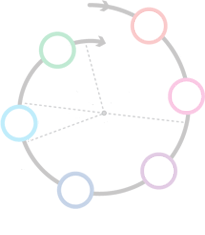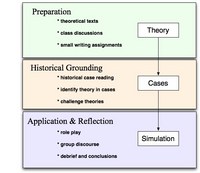Cases

Project Overview: Country X

|
Partner(s):
Aldo Civico School of International and Public Affairs Access: Private Released: April 2009 |
Country X is a web-based educational simulation created in response to challenges surrounding the training and education of prospective genocide prevention practitioners. The simulation, developed in partnership with Professor Aldo Civico of the Center for International Conflict Resolution, takes place in a fictitious nation experiencing rapid instability called Country X. Students work in groups of four, with each student assuming the identity of one of four characters representing the perspectives of diplomatic, intelligence, military, and civil society communities.
After analyzing a starting condition, players must address the situation from within their role by independently making a strategic policy decision and providing a rationale for it. The combination of player decisions at each phase of the simulation determines a resulting condition for Country X for better or worse. Students work through three such decision phases and then confront and attempt to deconstruct a final condition. The simulation was created to work in an integrated way with class discussions facilitated by an instructor. It is being used in Professor Civico's genocide prevention seminar and will also be available to other courses at Columbia.
Discovery: Country X
The concept behind Country X evolved from early conversations with Professor Aldo Civico who teaches a course on genocide prevention at the Center for International Conflict Resolution (CIRC). Historically, Professor Civico’s course on genocide prevention centered on two curricular phases: an overview of genocide theories and models, and then weeks of case study where students were tasked with recognizing the roots of theory in historical scenarios. The emphasis on case studies allowed students to focus on lost opportunities for prevention in the recent past, and the curricular rationale was that focusing on cases would provide students the necessary historical perspective to better prepare for future situations.
CCNMTL observed various workshops and classes taught by the client throughout the discovery phase to gain a better understanding of the subject and teaching approach. Once understanding the curricular context, work began on identifying gaps and uncovering what the teachable moments of the course should—or could—be.
The early collaboration led to an important clarification: that firm historical understanding was only part of what students should ideally take from a class in genocide prevention. Working off of this, a significant early hypothesis was made: hind-sight learning does not offer the nuanced perspective of a real-time devolution critical to understanding and acting on pre-genocidal conditions. Thus a central teaching question emerged: what is the right balance between theory and practice in a course about such a complex and poorly understood human phenomenon? Careful inquiry during the discovery phase enabled CCNMTL and Professor Civico to conclude that the current balance was tipped far too much to the historical/theoretical realm, and that students needed an opportunity in the course to consider how they would put the learned theories and historical knowledge of genocide prevention into practice, especially given the lack of predictive modeling in the field.
By the end of the discovery phase of the project, CCNMTL had identified three central Design Research problematics of the Genocide Prevention course:
- Too much focus on historical/theoretical understanding while not enough emphasis on practice
- No easy means to move the course continuum from genocide prevention theory to genocide prevention application
- No systematic way for the students to be trained as practitioners in genocide prevention
It was from these problematics uncovered in the discovery phase that CCNMTL and Professor Civico were able to hypothesize the solutions that would ultimately define the nature and design of Country X. In the CCNMTL Design Research approach, the search for solutions begins in the next stage of the methodology, that of Design.
 | Fig.1: Conceptual illustration of the proposed optimum sequence of content in the course to maximize the educational value of the simulation. |


